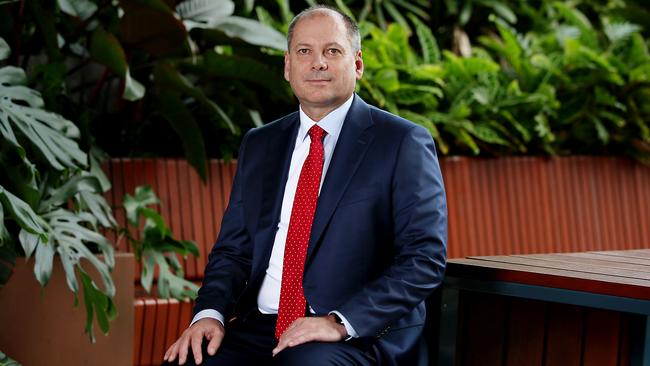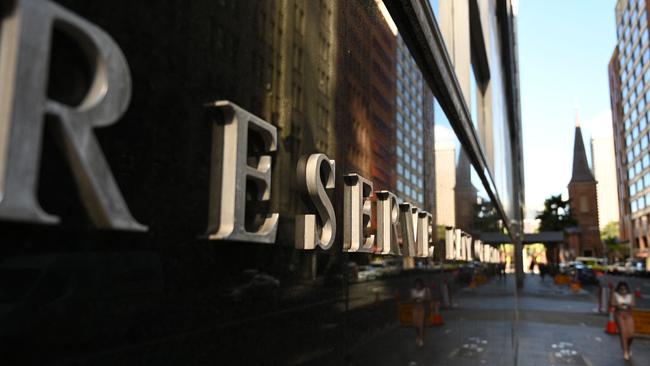As Westpac profit jumps, investors ask: can it shrink to greatness?
Westpac’s Peter King believes the turning point is near as he tries to reinvent Australia’s oldest bank into a leaner, modern, more responsive lender.

Westpac’s Peter King believes the turning point is near as he tries to reinvent Australia’s oldest bank into a leaner, modern, more responsive lender.
The former Westpac chief financial officer who took charge when a massive Austrac laundering scandal broke in late 2019, has a single number in his sights and inflation be damned, he is going to get there.
King wants to hit an annualised cost target of $8bn within two years. He has his work cut out and at the current run rate he needs to pull out $2.2bn in annualised costs after taking into account hotter-than-expected inflation and the prospect of a more subdued growth outlook.
The question is can Westpac shrink to greatness?
On all metrics Westpac should be bigger than National Australia Bank – a substantially bigger balance sheet, bigger market share with more customers across the board but it has fallen a long way behind the Melbourne-based bank.
Investors are rewarding NAB’s decision to play to its strengths giving it a $102bn market capitalisation, while Westpac, which could have been a contender for nation’s biggest bank, is sitting on $85bn – third placed and with a big blow to its pride.
King is not prepared to let this be a distraction.
“We’ve got our agenda, which we’re running to,” King tells The Australian in an interview. “I’m confident that the relative market value of this bank can go up once we deliver on the agenda”.

His vision is for Westpac to extract itself from wealth entirely and be a “pure bank”.
“But we need to be a digital bank – everything needs to be done digitally,” he adds.
King and his chairman John McFarlane have nailed their colours to the $8bn cost target, even as other banks, including ANZ have backed away from firm cost targets.
Given the directive has come from the very top they will get there. The fear is they will get there despite everything else. Effective cost cutting needs real re-engineering of systems and processes, which like everything takes a long time in a big bank.
King is certainly in a hurry. He says Westpac “needs to be a more efficient bank” and much of this will come through what he describes as digital efficiency. He also talks about simplicity – which is now becoming the catchphrase as banks are the world extract themselves from wealth management.
“We’ve still got a lot of work to do and so I and the board still believe that the right thing is for this company to be very focused on resetting this cost base,” he says. Already over the past year more than 4000 roles have been cut, although most of these positions are third party and people who have been working on specialist projects linked to remediation work since the Hayne royal commissions.
Customers will see more refinement in tech. King points to the new Westpac app that has just been relaunched for Apple users and now being rolled out to Android platform that has the ability for customers to apply online for mortgages, track applications, accept offer letters and monitor settlement via mobile. The app is also being rolled out to small and mid-sized business customers to allow loans to be arranged via digital.
The automation will bring down the costs because there will be fewer staff needed for servicing and maintenance of loans.
With the momentum from Covid lockdowns the digital shift is well under way, which will help Westpac’s cut costs.
Over-the-counter transactions in branches have fallen from 16.5 million in the March half of 2020, to 11.1 million today.
Call centre volumes are down over the same period by more than 1 million to 3.4 million while the percentage of sales through digital channels are up from 37 per cent to 45 per cent.
The physical presence of Westpac is shrinking too, with the ATM fleet halved to just over 1100 over two years as more people use cashless payments, and branch numbers down by 150.
Westpac, likely all banks, is seeing a large proportion of costs tied up in regulatory spending and customer compensation. This is starting to already roll off, leaving more room for investment, and then banks need a long lead time to see this translate to significant revenue gains.

Even so, shareholders like short-term wins on costs. Better-than-expected wins on costs helped Westpac deliver a surprise 71 per cent lift in cash profit to $3.09bn for the Match half. With costs down more than 10 per cent, and promises of more to come, investors sent Westpac shares 3.2 per cent higher to $24.60. Helping the share price lift, the bank also declared a 61c per share dividend, up a cent on the September half.
Westpac is coming off a lost decade where all the growth in the business has been chewed up by higher expenses. Arguably Westpac suffered from underinvestment leading into the 2010s that sapped it of momentum and put it behind rivals in terms of tech.
The equivalent results a decade ago, for the first half of 2012, saw pre-provision profit of $4.93bn compared to $4.86bn today. Expenses were running at an annualised rate of just under $8bn, compared to $10.5bn today.
Other shareholder metrics, including interim dividend, earnings per share and return on equity have gone substantially backwards and the bank is smaller as it has exited businesses and collapsed its St George division into the retail bank.
However staff numbers and average lending book has increased over the same period. Tellingly Westpac’s shares are up 8.5 per cent over the 10 years compared to a 66 per cent gain in the S&P/ASX 200.
‘Momentum drive’
Westpac should ride the pick up in cash rates to benefit the traditional strength of investor lending as well as improve margins on its flagship retail banking business, where it has a 22 per cent share in mortgages. It is also seeing renewed momentum in small to medium-sized business lending where it remains strong.
In institutional lending Westpac is looking at capturing a slice of the renewables boom. Here, it has moved back into carbon trading which is an area it initially tried early last decade. In doing so, Westpac is taking carbon certificate risk on its balance sheet as it offers hedging and buying and selling of renewable energy certificates on behalf of big business customers.
King’s wealth businesses including life insurance and the wealth platforms are still on track for a sale. This, says King will free up Westpac because much of the remediation and compensation to customers in recent years has been across wealth management.
King cautions the expected speed of interest rate rises, the bank is tipping official cash rates to move to 2.25 per cent by the middle of 2023. Westpac has been factoring in a 3 per cent buffer on the cash rate and is confident his customers will take this in their stride, particularly with unemployment low.
Even so he points out this could be a hit to consumer confidence.
“The average new mortgage is a bit over $500,000. So if rates go up 2 per cent, that’s $10,000 in after tax income per year, so the Reserve Bank’s got a real balancing act here to appropriately raise rates.”
If they overdo it, it really could impact on confidence and activity, King says.
johnstone@theaustralian.com.au







To join the conversation, please log in. Don't have an account? Register
Join the conversation, you are commenting as Logout